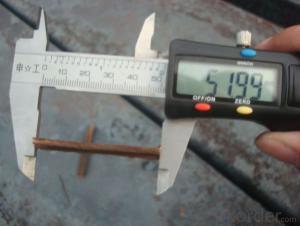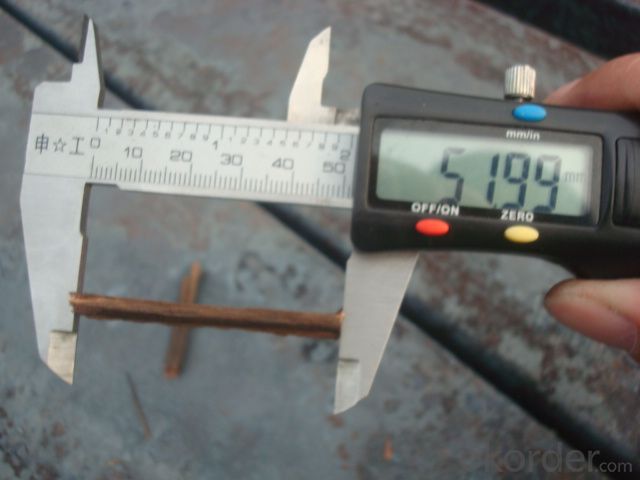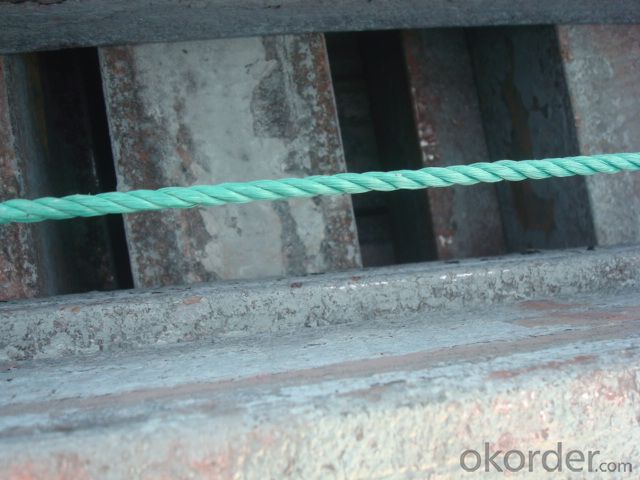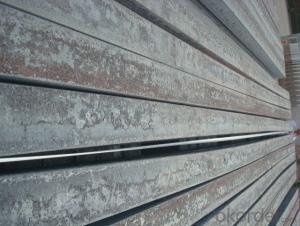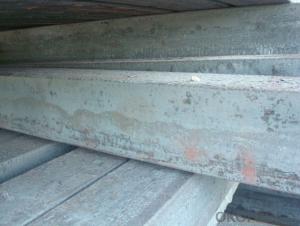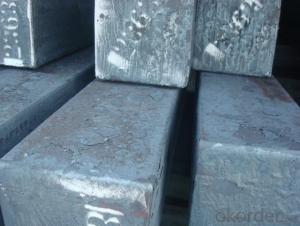Alloyed Continue Casting Steel Billet by Blast Furnace with Good Quality
- Loading Port:
- Tianjin
- Payment Terms:
- TT OR LC
- Min Order Qty:
- 1000 m.t.
- Supply Capability:
- 10000 m.t./month
OKorder Service Pledge
OKorder Financial Service
You Might Also Like
Alloyed Continue Casting Steel Billet by Blast Furnace with Good Quality
1.Structure of Alloyed Continue Casting Steel Billet by Blast Furnace with Good Quality
Alloyed Continue Casting Steel Billet by Blast Furnace with Good Quality is the raw material of all kinds of steel mill. Billet section of square, round, flat, rectangular and abnormity, etc Several, mainly related to shape of rolled products. Simple rolled section steel, choose cross section of square billet or rectangular billet. rolling The sector products such as flat steel, Angle steel, select the rectangular billet or slab. Had better profiled billet when production beams, channels, and in rolling process Lines and improve the yield. The raw material of round billet is the production of seamless tube.
2.Main Features of Alloyed Continue Casting Steel Billet by Blast Furnace with Good Quality.
Alloyed Continue Casting Steel Billet by Blast Furnace with Good Qualitysection size should meet the requirements of rolling deformation and finished product quality, but also roll strength and biting condition of restrictions. General steel Billet section height H. And the roll diameter D The ratio of the ( namely H/D) Should be less than or equal to zero 0.5 . Length of steel billet by finishing temperature, Rolling time and the length of the product Or times ruler. When heated too long accident prone to bump the furnace wall of steel, too short, furnace bottom utilization rate is not high, influence the heating furnace production. For the production Choose a variety of steel and steel billet, should consider the affinities of billet, as far as possible in order to improve the productivity of the roughing mill, simplify the stock management of workshop.
3. Alloyed Continue Casting Steel Billet by Blast Furnace with Good Quality Images
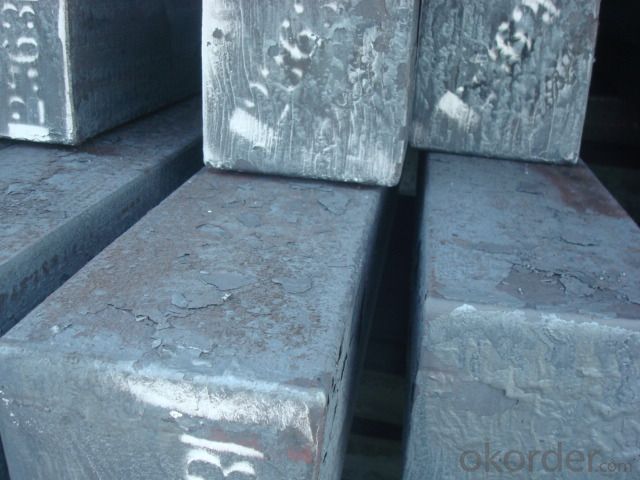

4. Alloyed Continue Casting Steel Billet by Blast Furnace with Good Quality Specification
Alloyed Continue Casting Steel Billet by Blast Furnace with Good Qualityrolled steel, after processing can be used for mechanical parts, forging parts, processing all kinds of steel, steel Q345B channel steel, wire rod is the role of the billet. Steel billet is used in the production of semi-finished products, generally cannot be used directly for the society. Steel billets and steel are strictly divided into standard, cannot decide to whether the business enterprise of the final product, and according to unified standards to perform the whole society. Typically, billet and the steel is relatively easy to distinguish, but for some steel billet, and have the same specification and same steel purposes (such as rolling tube billet), whether can be used for other industries, whether through steel processing process, whether through a finished product rolling mill processing to distinguish
Material standard The editor Range of thickness: 150-240 - mm + / - 5 mm width range: 880-1530 - mm + / - 20 mm Length: 3700-10000 - mm + / - 500 - mm Cross-sectional size: 64 * 64; 82 * 82; 98 * 98; 124 * 124; 120 * 150; 152 * 164; 152 * 170 mm Length: 9000 mm Section of tolerance: billet: 1.0 + / - 2.0-1.0 + / - 1.0 mm slab: width: + / - 2.0 mm thickness: + / - 3.0 mm The length tolerance: + / - 200 mm Section diagonal tolerance: 3.5-8.0 MM Billet section size protrusions requirements: < 1242 mm, do not allow; > = 1242 mm, < = 2 mm 1242 mm, < = 3 mm Beheading (shear) extension deformation: < 1242 mm billet: no control; The slab: < = 15 mm Surface tilt: no more than billet section 0.1 Bending: every 1 m length is not more than 10 mm The distortion: length < = 5 m, < = 11. ; The length of the < = 7.5 M, < = 5. Material % 3 sp/PS chemical composition: C Mn Si S P
5.FAQ of Alloyed Continue Casting Steel Billet by Blast Furnace with Good Quality
We have organized several common questions for our clients,may help you sincerely:
①How about your company?
A world class manufacturer & supplier of castings forging in carbon steel and alloy steel,is one of the large-scale professional investment casting production bases in China,consisting of both casting foundry forging and machining factory. Annually more than 8000 tons Precision casting and forging parts are exported to markets in Europe,America and Japan. OEM casting and forging service available according to customer’s requirements.
②How can we know the quality of each steel mill you recommand?
We will show you the steel mills website, production line, stock warehouses and other information open for you.And you can hire the SGS inspect for you too.
③How long is the delivery term if we order about 10,000tons?
Our production term is about 30 days. And if your specification is normal, it can be shorter.
- Q: What are the main factors that determine the demand for steel billets in different industries?
- The demand for steel billets in different industries is influenced by several factors. 1. Economic conditions: The overall state of the economy plays a crucial role in determining the demand for steel billets. During periods of economic growth and increased construction activities, there is typically a higher demand for steel billets in industries such as construction, infrastructure, and manufacturing. 2. Construction and infrastructure projects: The demand for steel billets is closely tied to construction and infrastructure projects. These projects require substantial amounts of steel for various purposes, including structural support, reinforcement, and fabrication. The level of investment in construction and infrastructure projects directly affects the demand for steel billets. 3. Manufacturing activities: Steel billets are used as raw material in various manufacturing processes, including automotive, aerospace, machinery, and equipment manufacturing. The demand for steel billets in these industries is directly influenced by the level of manufacturing activities and the overall production output. 4. Technological advancements: Technological advancements and innovation can also impact the demand for steel billets. As new technologies emerge and industries evolve, the demand for steel billets may change. For example, the rise of electric vehicles has increased the demand for steel billets in the automotive industry due to the need for lightweight yet strong materials. 5. International trade and globalization: The demand for steel billets can be affected by international trade dynamics and globalization. The expansion of global supply chains and the growth of emerging economies can lead to increased demand for steel billets in different regions. Changes in trade policies or tariffs can also influence the demand for steel billets in certain industries. 6. Environmental regulations: Increasing environmental regulations and sustainability initiatives can impact the demand for steel billets. Industries that are required to reduce their carbon footprint may opt for alternative materials or adopt more efficient manufacturing processes, which could affect the demand for steel billets. 7. Price and availability: The price and availability of steel billets can significantly impact demand. Fluctuations in steel prices, supply chain disruptions, or shortages of raw materials can influence the demand for steel billets in different industries. Additionally, the availability of substitutes or alternative materials can also affect the demand for steel billets. In conclusion, the demand for steel billets in different industries is influenced by economic conditions, construction and infrastructure projects, manufacturing activities, technological advancements, international trade, environmental regulations, and price and availability factors. Understanding these factors is essential for predicting and analyzing the demand for steel billets in various industries.
- Q: What are the safety precautions to be taken while handling steel billets?
- When handling steel billets, there are several safety precautions that should be followed to ensure the well-being of individuals as well as the integrity of the material. Some key safety precautions include: 1. Personal Protective Equipment (PPE): It is essential to wear appropriate PPE such as gloves, safety glasses, and steel-toed boots to protect against potential injuries. Steel billets are heavy and can cause severe harm if dropped or mishandled. 2. Proper Lifting Techniques: When lifting steel billets, it is crucial to use proper lifting techniques, such as bending at the knees and keeping the back straight. This helps prevent strains, sprains, and other musculoskeletal injuries. 3. Adequate Training: Workers should receive proper training on how to handle steel billets safely. This includes understanding the weight and dimensions of the billets, knowing how to move them safely, and being aware of potential hazards. 4. Secure Storage and Transportation: Steel billets should be stored and transported in a secure manner to prevent accidents. They should be properly stacked, secured, and not overloaded to avoid falling or shifting during handling. 5. Clear Communication: In a work environment where multiple individuals are involved in handling steel billets, clear communication is essential. This includes using appropriate signals and verbal communication to coordinate movements and ensure everyone's safety. 6. Inspect Equipment: Before handling steel billets, it is important to inspect the equipment being used, such as cranes, forklifts, or other lifting devices. This helps identify any potential issues or malfunctions that could compromise safety. 7. Regular Maintenance: Regular maintenance of equipment used for handling steel billets is crucial to ensure their proper functioning. This includes inspections, repairs, and replacements as needed. 8. Hazard Identification: Workers should be trained to identify potential hazards associated with handling steel billets, such as sharp edges, hot surfaces, or slippery floors. Identifying and addressing these hazards promptly can prevent accidents and injuries. 9. Ergonomic Considerations: Ergonomic factors should be considered when designing workstations and handling procedures. This includes ensuring proper height and reach distances, providing adequate space for movement, and using tools or equipment that reduce strain on the body. 10. Emergency Response: Lastly, workers should be aware of emergency response procedures in case of accidents or injuries. This includes knowing the location of first aid kits, fire extinguishers, emergency exits, and how to report incidents to supervisors. By following these safety precautions, individuals can mitigate the risks associated with handling steel billets and create a safer work environment.
- Q: How are steel billets used in the production of oil and gas pipelines?
- Steel billets are used in the production of oil and gas pipelines as they serve as the raw material for manufacturing pipeline sections. These billets are heated, shaped, and welded to form seamless or welded pipeline pipes. The high strength and durability of steel make it an ideal material for pipelines, providing a reliable and safe means of transporting oil and gas over long distances.
- Q: What are the different heat treatment processes for alloy steel billets?
- There are several different heat treatment processes for alloy steel billets, including annealing, normalizing, quenching, and tempering. Annealing involves heating the billets to a high temperature and then slowly cooling them to relieve internal stresses and improve ductility. Normalizing is similar to annealing but involves air cooling instead of slow cooling. Quenching involves rapidly cooling the billets in a liquid medium, such as oil or water, to increase hardness and strength. Tempering is done after quenching and involves reheating the billets to a specific temperature and then cooling them slowly to reduce brittleness and improve toughness.
- Q: How are steel billets used in the manufacturing of medical devices?
- Steel billets are used in the manufacturing of medical devices as a raw material for shaping and forming various components. They are often melted down and poured into molds to create intricate shapes and designs required for medical devices such as surgical instruments, implants, and prosthetics. The high strength and durability of steel make it an ideal choice for ensuring the longevity and reliability of these devices, ensuring they can withstand the rigorous demands of medical applications.
- Q: What is the difference between steel and billet in the process?
- My understanding is that..:Billet: Billet, refers to the casting of roughSquare steel: Square, Bar, the product is rolled on the basis of square billet.
- Q: What are the different surface finishes available for tool steel billets?
- There are several different surface finishes available for tool steel billets, depending on the specific requirements and applications. Some common surface finishes include: 1. Hot Rolled: This is the most basic surface finish, where the steel billets are hot rolled to achieve a rough and scaled surface. It is suitable for applications where a smooth finish is not crucial. 2. Cold Rolled: In this process, the steel billets are cold rolled to achieve a smoother and more refined surface finish. Cold rolled surfaces are often used when a higher degree of precision and accuracy is required. 3. Turned: This surface finish is achieved by using a lathe to remove material from the steel billet, resulting in a smooth and polished surface. Turned surfaces are commonly used in applications where aesthetic appearance is important, as well as for precision components. 4. Ground: Grinding is used to achieve a flat and smooth surface finish on tool steel billets. It is commonly used when a high level of precision and dimensional accuracy is required, such as for tooling applications. 5. Polished: This is the most refined surface finish, achieved by using abrasives and polishing compounds to create a mirror-like surface. Polished surfaces are often used for decorative or high-end applications, where a visually appealing finish is desired. 6. Coated: Tool steel billets can also be coated with various materials to enhance their surface properties. Examples include coatings like nitride, carbide, or diamond-like carbon (DLC), which can improve hardness, wear resistance, and friction properties. The choice of surface finish for tool steel billets depends on the specific requirements of the application, such as desired accuracy, appearance, and performance characteristics.
- Q: How do steel billets contribute to the manufacturing of telecommunications equipment?
- Steel billets play a crucial role in the manufacturing of telecommunications equipment by providing the necessary raw material for various components and structures. These billets, typically made from carbon steel, are semi-finished products that are further processed to create specific shapes and sizes required for telecommunications equipment. One of the key ways steel billets contribute to the manufacturing of telecommunications equipment is by serving as the base material for the fabrication of towers and masts. These structures are vital for the installation of antennas and satellite dishes, enabling the transmission and reception of signals for telecommunications networks. Steel billets are shaped and welded to create sturdy and durable towers that can withstand various environmental conditions. Moreover, steel billets are also used in the production of enclosures and cabinets for housing telecommunication equipment. These enclosures provide protection from external factors such as dust, moisture, and vandalism, ensuring the proper functioning and longevity of the equipment. Steel billets are formed into panels, frames, and chassis that are then assembled to create robust enclosures that can withstand harsh environments. In addition, steel billets contribute to the manufacturing of telecommunications equipment by being used in the production of cable trays and supports. These components are essential for organizing and routing cables, providing a neat and efficient infrastructure for telecommunications systems. Steel billets are rolled and formed into various shapes, such as channels and angles, to create sturdy cable trays and supports that can handle the weight and stress of multiple cables. Furthermore, steel billets are also utilized in the fabrication of connectors and brackets for telecommunications equipment. These small yet crucial components provide the necessary connections and support for different devices and modules in telecommunications systems. Steel billets are machined, drilled, and shaped into specific designs to create reliable connectors and brackets that ensure proper functionality and stability. Overall, steel billets play a vital role in the manufacturing of telecommunications equipment by providing the necessary raw material for various components and structures. Their strength, durability, and versatility make them an ideal choice for creating robust and reliable equipment that can withstand the demands of modern communication networks.
- Q: What are the common surface defects found in steel billets?
- Common surface defects found in steel billets include: 1. Scale: Scale is a type of oxide layer that forms on the surface of steel due to exposure to high temperatures during the manufacturing process. It appears as a flaky, rough layer and can affect the quality of the steel. 2. Surface cracks: Cracks can form on the surface of steel billets due to various reasons such as improper cooling, improper handling, or excessive stress during the manufacturing process. These cracks can weaken the steel and reduce its structural integrity. 3. Inclusions: Inclusions are non-metallic impurities that can be present in the steel billet. These impurities can be in the form of oxides, sulfides, or other foreign materials. Inclusions can cause weak spots in the steel, leading to potential failures or defects in the final product. 4. Decarburization: Decarburization is the loss of carbon content from the surface of the steel billet. It occurs when the steel is exposed to high temperatures for an extended period or inadequate protective atmospheres during the manufacturing process. Decarburization can reduce the hardness and strength of the steel. 5. Surface roughness: Steel billets may have surface irregularities or roughness due to improper processing or handling. This can affect the surface finish and overall appearance of the billet. 6. Roll marks: Roll marks are impressions or patterns left on the surface of the steel billet during the rolling process. These marks can be caused by issues with the rolling mill equipment, such as improper alignment or worn-out rolls. 7. Lamination: Lamination refers to the presence of layers or separations within the steel billet. This defect can occur due to improper solidification during the casting process, inadequate temperature control, or the presence of impurities. It is important to detect and address these surface defects in steel billets to ensure the production of high-quality steel products. Various inspection techniques, such as visual inspection, ultrasonic testing, magnetic particle testing, and eddy current testing, can be used to identify and classify these defects.
- Q: What are the different types of surface treatment defects found in steel billets?
- Some of the different types of surface treatment defects found in steel billets include scale, pits, cracks, scratches, and surface contamination. These defects can occur due to various factors such as improper cleaning, handling, or storage, as well as the presence of impurities in the steel or the surface treatment process itself.
Send your message to us
Alloyed Continue Casting Steel Billet by Blast Furnace with Good Quality
- Loading Port:
- Tianjin
- Payment Terms:
- TT OR LC
- Min Order Qty:
- 1000 m.t.
- Supply Capability:
- 10000 m.t./month
OKorder Service Pledge
OKorder Financial Service
Similar products
Hot products
Hot Searches
Related keywords
